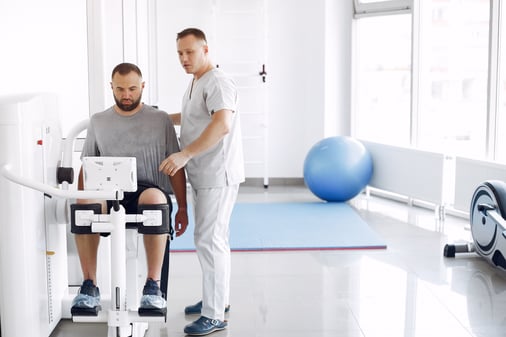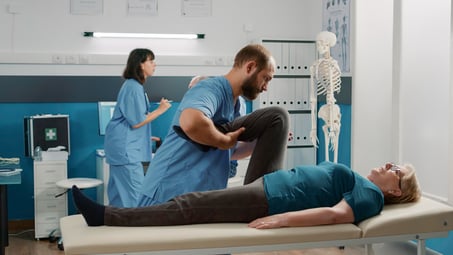January 11, 2024
How Modern Physical Therapy is Revolutionizing Rehabilitation
The realm of physical therapy has undergone a remarkable transformation over the years, evolving from traditional methods to the innovative techniques and treatments of modern physical therapy. This revolution has not only changed the way we approach rehabilitation but has also significantly enhanced the effectiveness of treatments.
In this article, we delve into the evolution of physical therapy, the benefits of modern approaches, and delve into some of the top techniques shaping the landscape.
How Has Physical Therapy Changed Over the Years?
 The roots of physical therapy lie in the pursuit of relieving pain and restoring function. However, the journey from those foundational principles to the present day represents a seismic shift. Today's physical therapy landscape is characterized by a departure from the conventional, embracing a holistic and patient-centric approach.
The roots of physical therapy lie in the pursuit of relieving pain and restoring function. However, the journey from those foundational principles to the present day represents a seismic shift. Today's physical therapy landscape is characterized by a departure from the conventional, embracing a holistic and patient-centric approach.
In private practices and clinics, this evolution means more than just adapting—it means thriving in an era where personalization and innovation reign supreme. For instance, as part of this revolution, practice management software streamlines patient scheduling, automates billing and insurance processes, and allows therapists to focus on what matters most: their patients' well-being.
These innovative tools allow clinics to deliver a seamless and personalized experience, fostering stronger patient engagement and ultimately driving better outcomes.
Is Modern Physical Therapy More Effective?
Telehealth: Breaking Geographical Barriers
In the realm of private practices, the advent of telehealth has ushered in a new era of accessibility. No longer confined by geographical limitations, patients can connect with therapists from the comfort of their homes. For clinic owners, this translates to a broader reach, increased patient engagement, and the ability to extend services beyond the clinic walls.
Streamlined Billing Management Through Software
The management of billing processes is a crucial aspect of running a successful practice. Modern physical therapy recognizes this and has embraced sophisticated billing management software. This isn't just about simplifying administrative tasks; it's about ensuring a seamless and efficient financial workflow for private practices. With automated billing, errors are minimized, and the focus can shift from paperwork to patient care.
Enhanced Patient Engagement and Retention
Modern physical therapy emphasizes patient engagement, and this is particularly pertinent for private practices. From interactive apps to personalized exercise programs, engaging patients in their rehabilitation journey is not just a trend but a cornerstone of success. This heightened engagement doesn't only lead to better outcomes; it fosters patient loyalty, a crucial factor in the sustained growth of private practices.
Data-Driven Decision Making
In the world of private practice management, informed decisions are paramount. Modern rehab physical therapy integrates data-driven insights into the decision-making process. With electronic health records and analytics tools, clinic owners can analyze trends, track patient progress, and optimize resource allocation. This empowers practices to evolve and adapt based on real-time information.
Simplified CPT Coding, Modifiers, and ICD-10 Codes
Navigating the intricacies of CPT coding, modifiers, and ICD-10 codes is a challenge that private practices often face. Modern physical therapy, with the assistance of practice management software, simplifies this process. The software streamlines coding procedures, reducing the likelihood of errors and ensuring accurate documentation, ultimately leading to smoother reimbursement processes.
Top 6 Physical Therapy Modern Techniques

Here are some of the techniques that embody the modern era of physical therapy, each contributing to the holistic approach that private practices strive to provide.
1. Blood Flow Restriction (BFR) Therapy
BFR Therapy is a beacon of precision in the modern physical therapy landscape. By strategically restricting blood flow to certain muscles during exercises, this technique induces a metabolic stress response, promoting efficient muscle growth and functional improvement. For private practices, BFR Therapy offers a targeted approach that maximizes results in shorter durations, aligning with the demands of a busy clinic schedule.
2. Trigger Point Dry Needling
Pain management is a critical aspect of rehabilitation, and Trigger Point Dry Needling stands at the forefront. By inserting fine needles into trigger points, this technique stimulates the release of tension and alleviates pain. For private practices, integrating dry needling not only expands the scope of services but also addresses the growing demand for effective pain management solutions.
3. Pelvic Floor Physical Therapy
In the realm of private practices, catering to a diverse patient base is essential. Pelvic Floor Physical Therapy is a versatile technique that goes beyond the conventional, addressing conditions related to the pelvic region. By incorporating this specialized approach, private practices can offer a comprehensive suite of services, attracting a broader clientele and distinguishing themselves in the competitive landscape.
4. Proprioceptive Neuromuscular Facilitation (PNF)
PNF Therapy is a cornerstone in modern movement physical therapy, focusing on enhancing functional mobility patterns through proprioceptive stimuli. For private practices, PNF offers a dynamic and adaptable approach, allowing therapists to tailor interventions to each patient's unique needs. The emphasis on functional movement aligns seamlessly with the goal of optimizing overall functionality and improving the quality of life for patients.
5. Instrument-Assisted Soft Tissue Mobilization (IASTM)
In the pursuit of precision, IASTM stands as a modern technique that leverages specially designed instruments to mobilize soft tissues effectively. For private practices, incorporating IASTM enhances the therapist's ability to target specific areas, accelerating recovery and fostering patient satisfaction. The precision offered by IASTM aligns with the ethos of private practices striving for excellence in patient care.
6. Aquatic Physical Therapy
In the spectrum of modern physical therapy, Aquatic Physical Therapy emerges as a refreshing alternative. By leveraging the buoyancy and resistance of water, this technique provides a low-impact yet highly effective avenue for rehabilitation.
For private practices, introducing aquatic therapy not only diversifies services but also appeals to a broader demographic, including those with musculoskeletal conditions and arthritis.
Traditional Physical Therapy vs Modern Techniques: A Paradigm Shift

Physical therapy has shed its traditional skin, embracing a revolutionary approach focused on holistic care and personalized strategies. Gone are the days of cookie-cutter exercises and passive modalities. Today, therapists wield cutting-edge tools and personalized plans to maximize rehabilitation.
- Traditional PT: Imagine rows of patients performing generic stretches, relying on heat packs and ice. Therapists, though skilled, often stuck to standardized protocols. While effective, it lacked personalization and adaptability.
- Modern PT: Now, imagine modern physical therapy equipment like practice management software guiding individual exercise programs based on detailed patient assessments, and techniques such as dry needling targeting specific pain points. By combining data-driven decisions with telehealth, access is expanded.
This shift isn't just about fancy tools. It's about treating the whole person, addressing physical, mental, and social well-being. Patients become active participants, setting goals and monitoring progress. This empowers them, leading to better outcomes and long-term success.
The future of PT shines brightly with personalized plans, advanced techniques, and technology enhancing every step. This revolution empowers both therapists and patients, ushering in a new era of rehabilitation excellence.
Why Patients Now Expect More from Physical Therapy
Modern patients are more informed, proactive, and goal-oriented than ever. They’re searching for:
-
Clinics that offer modern physical therapy services backed by technology and results
-
Efficient scheduling and telehealth options
-
Therapists who use evidence-based, hands-on techniques
-
Tools that show measurable improvement from visit to visit
-
A personalized rehab journey that feels collaborative, not clinical
Meeting these expectations helps your practice attract and retain patients who are deeply invested in their health and recovery.
Modern Physical Therapy's Game-Changer: PtEverywhere
In the intricate dance of managing a private practice, having a reliable ally is paramount. PtEverywhere seamlessly integrates into the fabric of modern physical therapy, providing a comprehensive solution for practice management.
From appointment scheduling, documentation, and billing to telehealth capabilities, PtEverywhere empowers physical therapists to navigate the complexities of running a clinic with ease.
With features tailored to the unique needs of private practices, PtEverywhere ensures a smooth and efficient workflow, allowing professionals to focus on what they do best—providing exceptional patient care.
Conclusion
As we navigate the modern landscape of physical therapy, private practices and clinics stand at the forefront of innovation and patient-centric care.
The fusion of technological advancements, data-driven strategies, cutting-edge techniques, and the strategic use of practice management software like PtEverywhere not only amplifies the effectiveness of rehabilitation but also solidifies the position of private practices as leaders in the field.
In this era of modern physical therapy, the opportunities for growth, patient satisfaction, and professional fulfillment are boundless for those who embrace the transformative wave of change.


